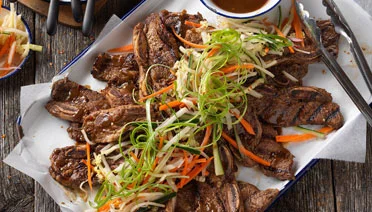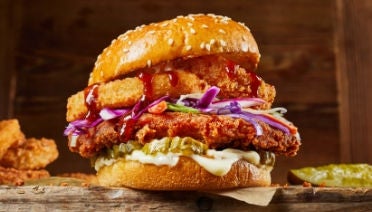TYSON FOODS, INC. TRADEMARKS AND REGISTERED TRADEMARKS ARE OWNED BY TYSON FOODS, INC. OR ITS SUBSIDIARIES.
3 Pork Shoulder Cuts That Make Great Menu Additions
Published: June 4, 2024
The pork shoulder primal is a staple of barbecue restaurants from coast to coast. And while operators may have varied opinions on which style of barbecue is best, most foodservice professionals agree this primal offers delicious flavor, ample intramuscular fat, outstanding versatility and cost effectiveness.
Three popular subprimal cuts—pork shoulder, pork butt and pork cushion—deliver those attractive attributes in varying degrees. And it’s their differences that foodservice operators will want to pay attention to when selecting cuts for their menus and customers.
The Pork Shoulder Primal
Located behind the head, the pork shoulder primal runs from the top of the leg down to the front of the foot. It contains muscles that are used for walking and seams of fat that run between the muscles.
Because of their fat content and connective tissue, cuts from the pork shoulder primal are best prepared with low, slow cooking methods such as barbecuing, braising and stewing.
All three cuts also can be used to make sausage, ground pork for meatballs, terrines and pâtés.
Good Things Come in Threes
Now that we’ve looked at attributes of the pork shoulder primal, let’s focus on the details of these three cuts.
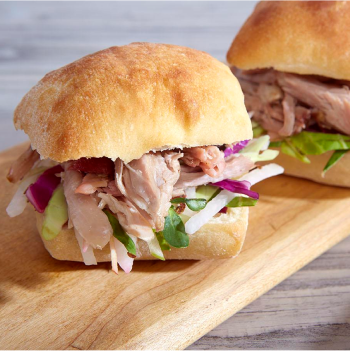
CUT NAME: PORK SHOULDER, AKA PICNIC SHOULDER
WHAT IT’S KNOWN FOR:
This cut comes from the triangle-shaped end of the pig’s shoulder, just above the front leg. It’s often sold with the skin on, which can be crisped to add crunch and flavor.
WHEN TO USE IT:
Pork shoulder is well-suited for slow-and-low smoking and roasting. It’s a perfect choice to use with heavier and more intense spice blends. Marinades with a high sodium mix can increase moisture retention.
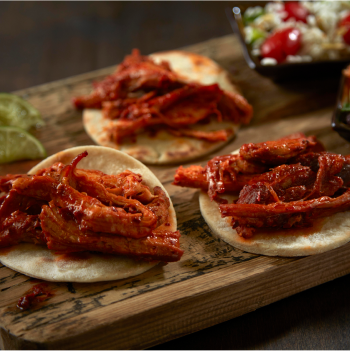
CUT NAME: PORK BUTT, AKA BOSTON BUTT
WHAT IT’S KNOWN FOR:
Cut from the upper part of the shoulder, pork shoulder also includes parts of the neck, shoulder blades and upper leg. It’s typically sold with the fat cap intact, and has a higher amount of intermuscular fat than other cuts from this primal.
WHEN TO USE IT:
Pork butt is often a key ingredient in Spanish and Asian cuisines due to its umami flavor qualities. The cut offers a wonderful texture after slow braising and makes a great sliced item when first roasted and cooled. It also absorbs spices and marinades well.
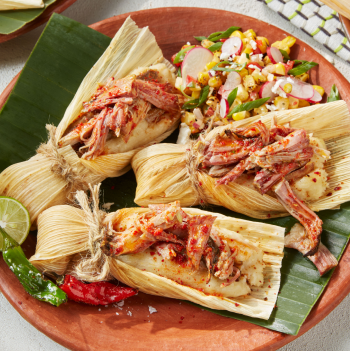
CUT NAME: PORK CUSHION
WHAT IT’S KNOWN FOR:
This triangle-shaped cut is the big lean muscle on the side of the shoulder. After deboning, it usually weighs three pounds. Pork cushion has a low overall fat content compared to other pork shoulder cuts, and a fair amount of connective tissue.
WHEN TO USE IT:
With their low fat content and generous connective tissue, pork cushion benefits from slow smoking, stewing or braising. Brining it in a high-sodium liquid before cooking or serving it with salsa or sauce can preserve moisture. This cut can also be portioned into cutlets, tenderized and then breaded before frying it in a shallow pan for crispy and tender results.

CUT NAME: PORK SHOULDER, AKA PICKNIC SHOULDER
WHAT IT’S KNOWN FOR:
This cut comes from the triangle-shaped end of the pig’s shoulder, just above the front leg. It’s often sold with the skin on, which can be crisped to add crunch and flavor.
WHEN TO USE IT:
Pork shoulder is well-suited for slow-and-low smoking and roasting. It’s a perfect choice to use with heavier and more intense spice blends. Marinades with a high sodium mix can increase moisture retention.

CUT NAME: PORK BUTT, AKA BOSTON BUTT
WHAT IT’S KNOWN FOR:
Cut from the upper part of the shoulder, pork shoulder also includes parts of the neck, shoulder blades and upper leg. It’s typically sold with the fat cap intact, and has a higher amount of intermuscular fat than other cuts from this primal.
WHEN TO USE IT:
Pork butt is often a key ingredient in Spanish and Asian cuisines due to its umami flavor qualities. The cut offers a wonderful texture after slow braising and makes a great sliced item when first roasted and cooled. It also absorbs spices and marinades well.

CUT NAME: PORK CUSHION
WHAT IT’S KNOWN FOR:
This triangle-shaped cut is the big lean muscle on the side of the shoulder. After deboning, it usually weighs three pounds. Pork cushion has a low overall fat content compared to other pork shoulder cuts, and a fair amount of connective tissue.
WHEN TO USE IT:
With their low fat content and generous connective tissue, pork cushion benefits from slow smoking, stewing or braising. Brining it in a high-sodium liquid before cooking or serving it with salsa or sauce can preserve moisture. This cut can also be portioned into cutlets, tenderized and then breaded before frying it in a shallow pan for crispy and tender results.
Pork Butt or Shoulder for Pulled Pork?
As you’ve probably guessed, pork butt and pork shoulder are great for pulled pork. Pork cushion works well, too. It all depends on the flavors and cooking methods you want to showcase to differentiate your menu.
Let Your Cultural Influences Run (Hog) Wild
In many cultures, pork is an ultimate comfort food. And comfort food is clearly something people crave frequently, with 82% of consumers reporting they indulge in comfort foods at least once a week—most often at dinnertime.1
As comfort food options go, stew remains a popular choice. According to Chef Christophe Setin, “The pork shoulder primal is the perfect cut for stews because of its fat content and naturally occurring umami qualities. Adding salt-rich condiments such as soy, teriyaki, oyster or steak sauce as well as garlic and fresh herbs will help enhance the qualities of this cut.”
“Pork cutlets are also gaining in popularity among breakfast and brunch enthusiasts. They can be served with fresh salsas and eggs as an alternative to steak and eggs.
- Chef Christophe Setin
Pork’s Place On Breakfast Menus
Of course, dinner isn’t the only daypart where pork can find a home. Pork at breakfast currently appears on 20.1% of all menus and is in the mature stage of the menu adoption cycle.2
What’s more, pulled pork’s inclusion on breakfast menus grew 10% over a recent 12-month period and reached 4.3% breakfast menu penetration according to a recent report from Datassential.3
“Pulled pork, flavored multiple ways, can be a great substitute for eggs Benedict,” says Chef Setin. “Pressed sandwiches made with brioche or croissant dough, then topped with sunny side up eggs or scrambled eggs, can be exciting new menu items.”
“Pork cutlets are also gaining in popularity among breakfast and brunch enthusiasts,” he adds. “They can be served with fresh salsas and eggs as an alternative to steak and eggs.”
Ready To Be Inspired With More Pork Menu Ideas?
There’s no shortage of ways to take advantage of pork’s versatility for your operation. Get inspired with menu ideas here.
Stay in the Know and Get Inspired with our Newsletter
Sign up for our newsletter to get on-trend menu ideas and more. You’ll be first to know about our great new products and get exclusive access to money-saving offers, business solutions, recipes and inspiration.
Related Content
Sources:
1. Comfort Food: Defined, Datassential, February 2023
2. Technomic, Ignite Menu National Food Trends Data, 2024
3. Breakfast Proteins, Datassential, November 2022
